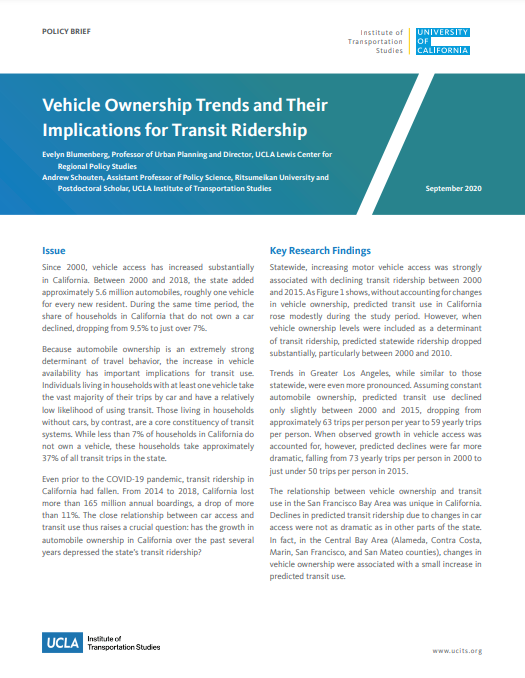Date: September 11, 2020
Author(s): Evelyn Blumenberg, Andrew Schouten, Andrew Schouten
Abstract
Since 2000, vehicle access has increased substantially in California. Between 2000 and 2018, the state added approximately 5.6 million automobiles, roughly one vehicle for every new resident. During the same time period, the share of households in California that do not own a car declined, dropping from 9.5% to just over 7%. Because automobile ownership is an extremely strong determinant of travel behavior, the increase in vehicle availability has important implications for transit use. Individuals living in households with at least one vehicle take the vast majority of their trips by car and have a relatively low likelihood of using transit. Those living in households without cars, by contrast, are a core constituency of transit systems. While less than 7% of households in California do not own a vehicle, these households take approximately 37% of all transit trips in the state. Even prior to the COVID-19 pandemic, transit ridership in California had fallen. From 2014 to 2018, California lost more than 165 million annual boardings, a drop of more than 11%. The close relationship between car access and transit use thus raises a crucial question: has the growth in automobile ownership in California over the past several years depressed the state’s transit ridership?
About the Project
From 2014 to 2018, California lost more than 165 million annual boardings, a drop of over 11%. This project examines public transit in California in the 2010s and the factors behind its falling ridership. Transit ridership has been on a longer-term decline in regions like Greater Los Angeles and on buses, while ridership losses in the Bay Area are more recent. While overall transit boardings across the state are down since 2014, worrisome underlying trends date back earlier as patronage failed to keep up with population growth. But reduced transit service is not responsible for ridership losses, as falling transit ridership occurred at the same time as operators instead increased their levels of transit service. What factors help to explain losses in transit ridership? Increased access to automobiles explains much, if not most, of declining transit use. Private vehicle access has increased significantly in California and, outside of the Bay Area, is likely the biggest single cause of falling transit ridership. Additionally, new ride-hail services such as Lyft and Uber allow travelers to purchase automobility one trip at a time and likely serve as a substitute for at least some transit trips. Finally, neighborhoods are changing in ways that do not bode well for public transit. Households are increasingly locating in outlying areas where they experience longer commutes and less transit access to employment. At the same time, a smaller share of high-propensity transit users now live in the state’s most transit-friendly neighborhoods.


